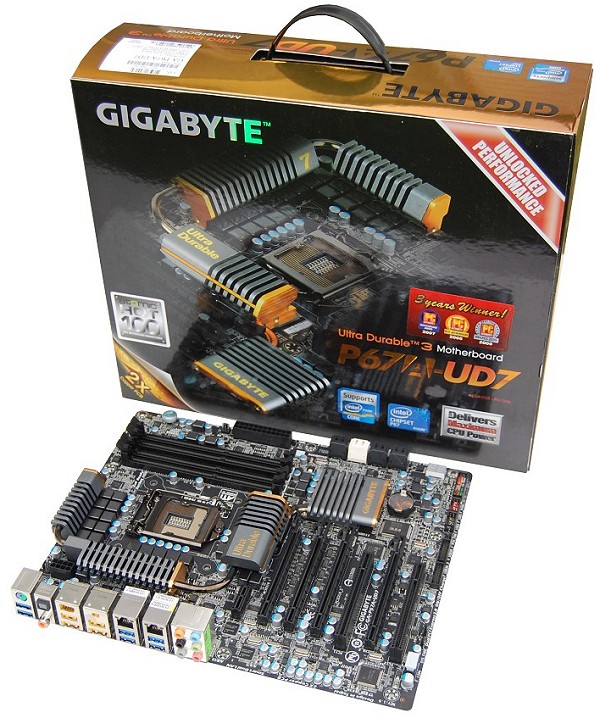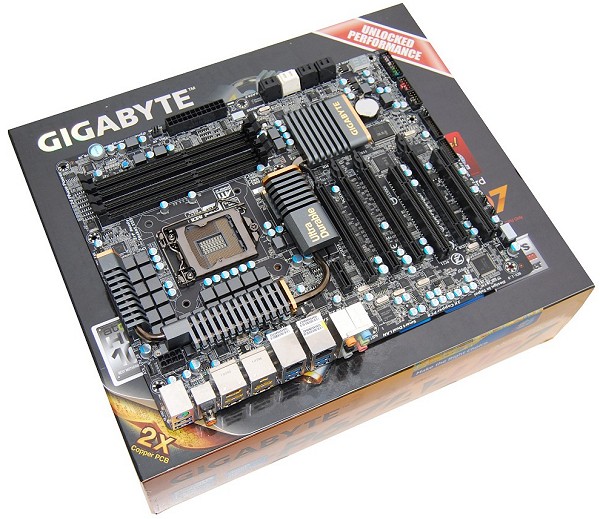Gigabyte P67A-UD7 – Features
Gigabyte has been quick to jump on the LGA1155 platform, having already launched half a dozen P67-based motherboards. The company's most extreme offering, and possibly the most aggressive looking board in our roundup, is the P67A-UD7.

Gigabyte has dropped their blue PCB and baby blue/white components in favor of a matte black design, at least for the majority of their P67 boards anyway. The P67A-UD7 is rather evil looking and perhaps the coolest looking board we have ever seen.

Aesthetics aside, the P67A-UD7 touts plenty of great features including dual Gigabit LAN, 8-channel audio, SATA 6Gb/s RAID, eSATA, USB 3.0 and a number of other innovative technologies.
The Gigabyte DualBIOS technology has been around for years and features two physical BIOS ROMs allowing users to quickly recover from BIOS damage, be that viruses or improper BIOS updating. In addition, DualBIOS now supports booting from 3TB+ (terabytes) hard drives without the need for partitioning, and enables more data storage on a single hard drive.
Gigabyte's On/Off Charge technology lets you charge a USB device regardless of whether your PC is on, in standby or even off. It also allows those devices to draw more current than standard USB ports allow, speeding up the recharging process by as much as 40%.

Gigabyte has also included a feature that called Turbo USB 3.0, which is said to boost performance by up to 10%. When enabled, the feature provides the fastest possible performance by allocating PCIe lanes to connect the CPU and USB 3.0 controller chip. This provides approximately 10% better performance than when it is disabled and USB 3.0 traffic is directed through the chipset.
It is worth noting that Turbo USB 3.0 utilizes eight PCIe VGA lanes, so it is only possible to enable it with a single graphics card running at PCIe x8 on P67 chipset motherboards.

The P67A-UD7 gets USB 3.0 from a pair of Renesas D720200 chips which are supported by a pair of VLI VL810 hubs. Each of the Renesas D720200 chips is connected to a PCI Express 2.0 x1 (5.0Gb/s) lane and provide two USB 3.0 ports. The two VLI VL810 hubs, which are actually made by VIA, replicate the Renesas ports.
The VLI VL810 from VIA is the industry's first fully integrated single chip solution that supports USB 3.0's transfer rates, allowing maximum data transfer rates of up to 5Gbps, or ten times the throughput available to USB 2.0 devices. The P67A-UD7 features ten USB 3.0-capable ports (six on the back panel, four via the USB brackets connected to the internal USB headers).

Also included is a Texas Instruments TSB43AB23 controller which provides FireWire (IEEE1394a) support for three ports. Two of the FireWire ports are on the back panel while the third comes from connecting the supplied bracket to the internal IEEE1394a header.

Gigabyte has also expanded the P67A-UD7's storage options by including two of the popular Marvell 88SE9128 controllers seen on the ECS board. Each controller supports a pair of SATA 6Gb/s ports along with NCQ (Native Command Queuing) and hardware RAID 0, 1, 5 and 10.
Two of these ports are situated onboard while the other two are located on the I/O panel where they provide eSATA connectivity. Both ports are self-powered meaning users can do away with power cords for their eSATA devices.

Gigabyte opted for the conventional Realtek ALC889 codec, which supports Dolby Home Theater and S/PDIF out while also providing 2/4/5.1/7.1 channel audio. Overall, the Gigabyte P67A-UD7 looks to be one of the best-equipped P67 motherboards available, though it's also one of the most expensive.